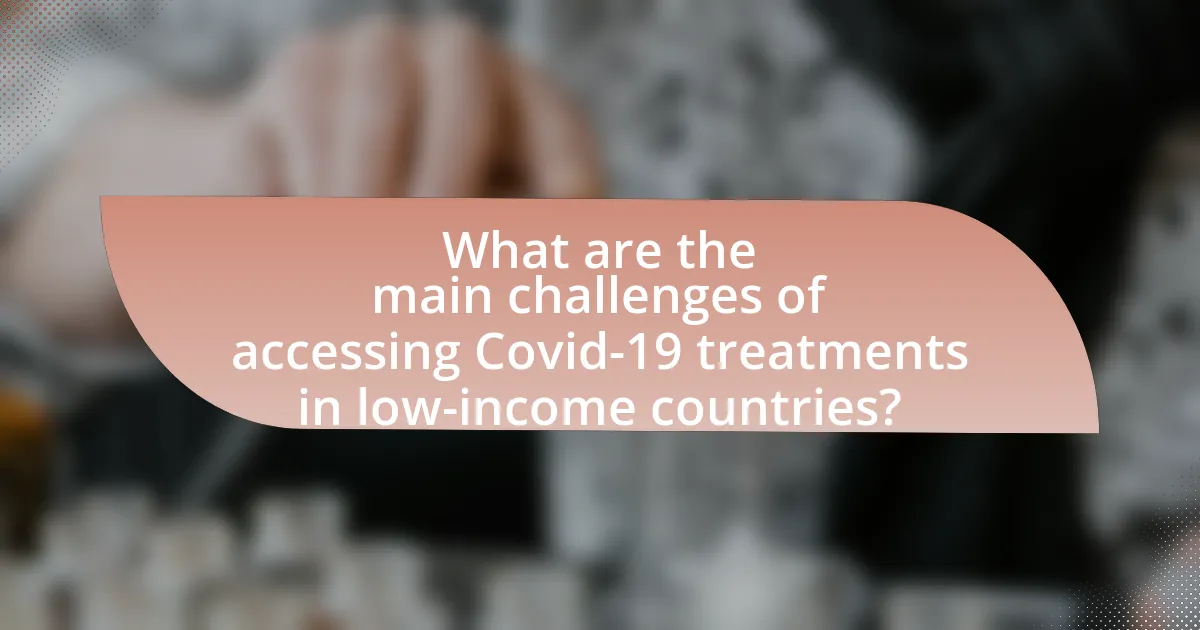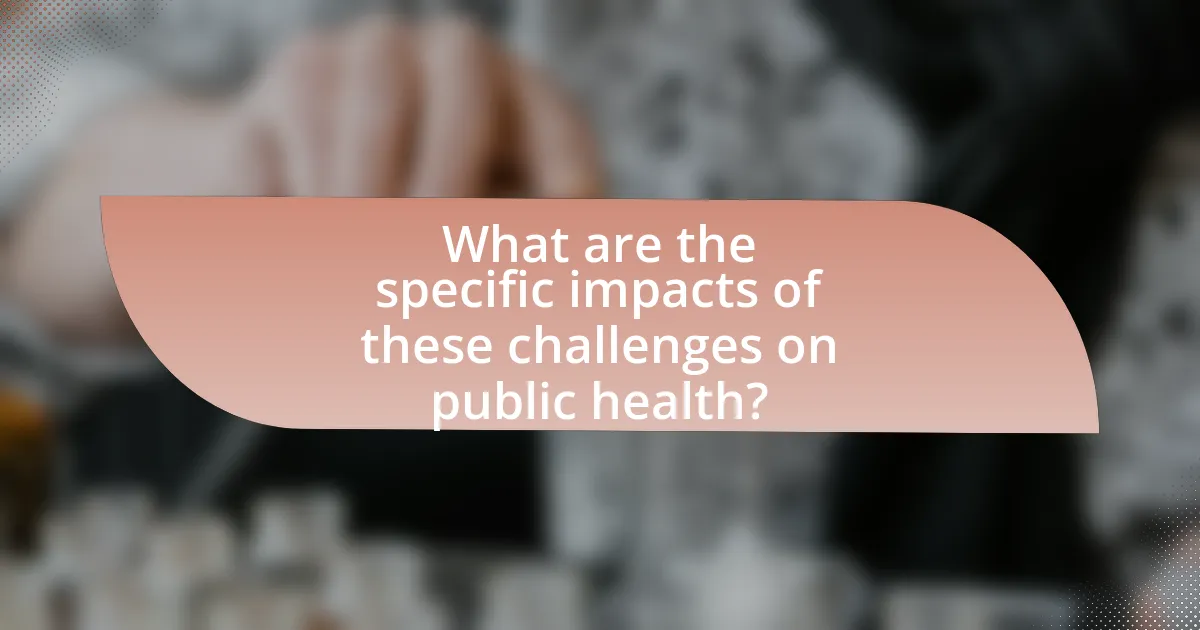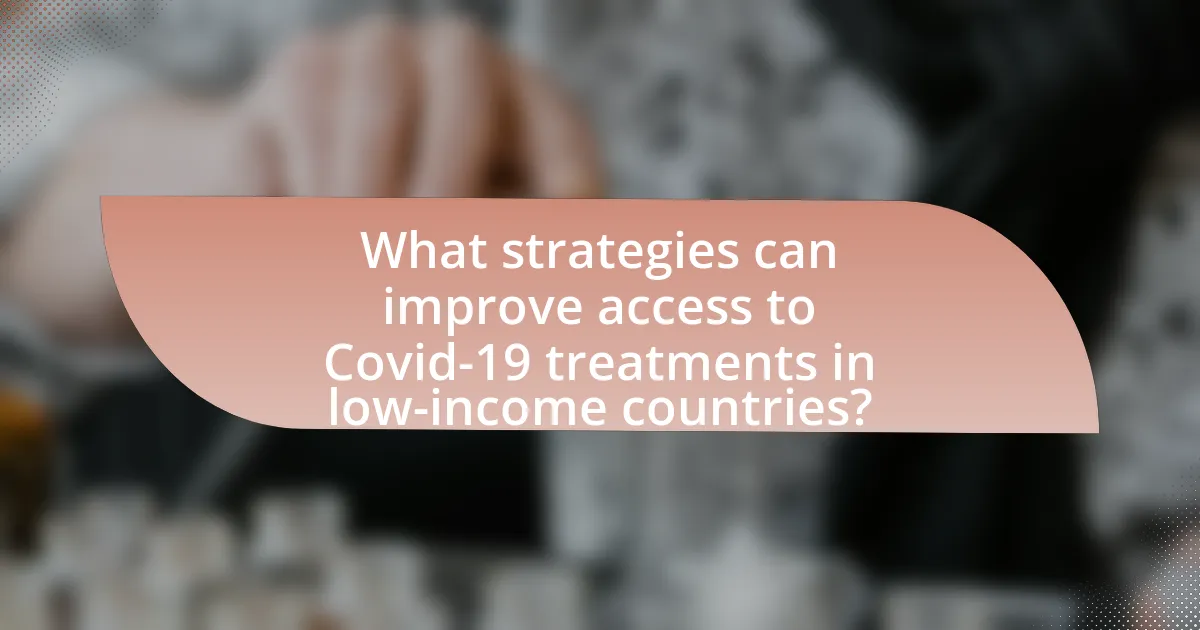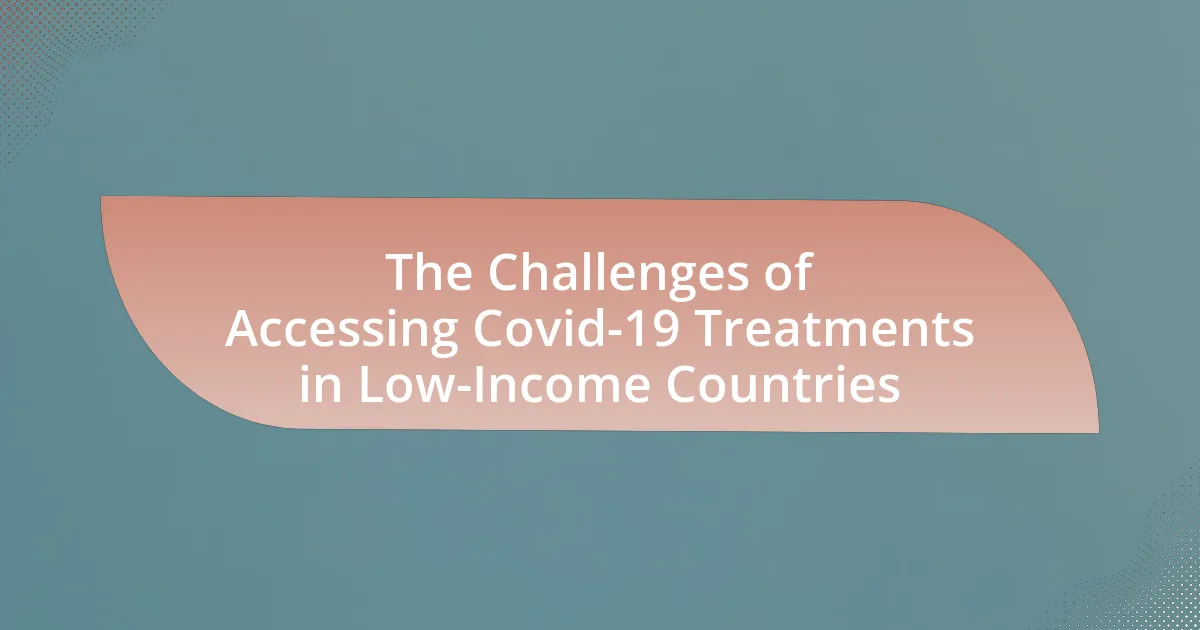The article examines the significant challenges faced by low-income countries in accessing Covid-19 treatments, highlighting issues such as limited healthcare infrastructure, high treatment costs, and inadequate supply chains. Economic factors, including poverty and healthcare budgets, further exacerbate these challenges, leading to disparities in health outcomes compared to high-income nations. Logistical barriers, regulatory issues, and the impact of patent laws also hinder treatment availability. The article discusses the implications of these challenges on public health, including increased mortality rates and the strain on healthcare systems, while proposing strategies for improving access through international cooperation, local manufacturing, and innovative solutions.

What are the main challenges of accessing Covid-19 treatments in low-income countries?
The main challenges of accessing Covid-19 treatments in low-income countries include limited healthcare infrastructure, high costs of treatments, and inadequate supply chains. Limited healthcare infrastructure often results in insufficient facilities and trained personnel to administer treatments effectively. High costs of treatments, particularly for novel therapies and vaccines, create financial barriers for both governments and individuals. Additionally, inadequate supply chains hinder the distribution of essential medications and vaccines, leading to delays and shortages. According to the World Health Organization, these factors contribute to significant disparities in health outcomes between low-income and high-income countries during the pandemic.
How do economic factors influence access to Covid-19 treatments?
Economic factors significantly influence access to Covid-19 treatments by determining the affordability and availability of healthcare resources. In low-income countries, limited financial resources restrict government spending on healthcare, leading to inadequate supply chains for treatments and vaccines. For instance, a study by the World Health Organization indicated that countries with lower GDP per capita faced greater challenges in securing sufficient Covid-19 vaccines, resulting in lower vaccination rates and limited access to treatments. Additionally, high out-of-pocket costs for patients can deter individuals from seeking necessary medical care, further exacerbating health disparities.
What role does poverty play in the availability of treatments?
Poverty significantly limits the availability of treatments, particularly in low-income countries. Individuals in poverty often lack access to healthcare facilities, which restricts their ability to receive timely and effective treatments. According to the World Health Organization, over 800 million people globally spend at least 10% of their household budget on health expenses, indicating that financial constraints directly impact treatment accessibility. Furthermore, low-income countries frequently face shortages of essential medicines and healthcare resources, exacerbating the challenges posed by poverty. This lack of resources is evident in the disparity of COVID-19 treatment availability, where wealthier nations can secure vaccines and therapeutics, while poorer nations struggle to obtain them due to financial limitations and inadequate healthcare infrastructure.
How do healthcare budgets affect treatment accessibility?
Healthcare budgets significantly influence treatment accessibility by determining the resources allocated for medical services, medications, and infrastructure. In low-income countries, limited healthcare budgets often result in inadequate funding for essential treatments, leading to shortages of necessary medications and healthcare personnel. For instance, a study published in The Lancet Global Health in 2021 highlighted that countries with lower healthcare expenditures per capita faced greater challenges in providing timely Covid-19 treatments, resulting in higher mortality rates. Thus, the correlation between healthcare budgets and treatment accessibility is evident, as insufficient funding directly restricts the availability and quality of healthcare services.
What logistical barriers exist in the distribution of Covid-19 treatments?
Logistical barriers in the distribution of Covid-19 treatments include inadequate transportation infrastructure, limited cold chain capabilities, and insufficient healthcare workforce. In low-income countries, poor road conditions and lack of reliable transport hinder timely delivery of treatments. Additionally, many Covid-19 treatments require refrigeration, and the absence of a robust cold chain system complicates storage and distribution. Furthermore, a shortage of trained healthcare personnel affects the administration and management of these treatments, leading to delays and inefficiencies in the distribution process. These barriers collectively impede access to essential Covid-19 treatments in vulnerable populations.
How does infrastructure impact the delivery of treatments?
Infrastructure significantly impacts the delivery of treatments by determining the availability and accessibility of healthcare services. In low-income countries, inadequate infrastructure, such as poor transportation networks and insufficient healthcare facilities, hinders timely access to Covid-19 treatments. For instance, a study by the World Health Organization in 2021 highlighted that countries with robust healthcare infrastructure were able to distribute vaccines more efficiently, achieving higher vaccination rates compared to those with limited infrastructure. This disparity illustrates how infrastructure directly influences the effectiveness of treatment delivery, ultimately affecting health outcomes in populations.
What are the challenges related to supply chains in low-income countries?
Supply chains in low-income countries face significant challenges, including inadequate infrastructure, limited access to technology, and regulatory barriers. Inadequate infrastructure, such as poor transportation networks and unreliable power supply, hampers the efficient movement of goods. Limited access to technology restricts the ability to track shipments and manage inventory effectively. Regulatory barriers, including complex customs procedures and inconsistent policies, further complicate the import and distribution of essential goods, including Covid-19 treatments. These factors collectively contribute to delays and increased costs in the supply chain, ultimately affecting the availability of critical healthcare resources.
How do regulatory issues affect access to Covid-19 treatments?
Regulatory issues significantly hinder access to Covid-19 treatments, particularly in low-income countries. These challenges include lengthy approval processes, stringent compliance requirements, and limited capacity for regulatory oversight, which delay the availability of essential medications. For instance, the World Health Organization reported that many low-income countries faced barriers in obtaining emergency use authorizations for Covid-19 vaccines and treatments, resulting in delayed access compared to higher-income nations. Additionally, regulatory frameworks often lack the flexibility needed to expedite the approval of innovative treatments during public health emergencies, further exacerbating the disparities in access to Covid-19 care.
What are the implications of patent laws on treatment availability?
Patent laws significantly impact treatment availability by restricting the production and distribution of medications, particularly in low-income countries. These laws grant exclusive rights to pharmaceutical companies, which can lead to high prices for patented treatments, limiting access for patients who cannot afford them. For instance, during the COVID-19 pandemic, patents on vaccines and therapeutics resulted in supply shortages and delayed access in many low-income nations, as seen with the limited distribution of mRNA vaccines. Consequently, the enforcement of patent laws can exacerbate health disparities, as countries with fewer resources struggle to negotiate lower prices or produce generic alternatives.
How do government policies influence the distribution of treatments?
Government policies significantly influence the distribution of treatments by determining funding allocations, regulatory frameworks, and access protocols. For instance, policies that prioritize healthcare funding can enhance the availability of Covid-19 treatments in low-income countries, while restrictive regulations may limit the importation of essential medications. Additionally, government initiatives, such as the COVAX program, aim to ensure equitable access to vaccines and treatments, demonstrating how policy frameworks can directly impact treatment distribution. In low-income countries, the lack of robust healthcare policies often leads to disparities in treatment availability, as evidenced by the World Health Organization’s reports highlighting the unequal distribution of Covid-19 vaccines globally.

What are the specific impacts of these challenges on public health?
The challenges of accessing COVID-19 treatments in low-income countries significantly impact public health by exacerbating health disparities and increasing morbidity and mortality rates. Limited access to effective treatments leads to higher rates of severe illness and death from COVID-19, as evidenced by studies showing that low-income populations experience disproportionately higher infection rates and poorer health outcomes. For instance, a report by the World Health Organization indicated that countries with lower healthcare resources faced a 50% higher mortality rate from COVID-19 compared to wealthier nations. Additionally, the inability to access treatments contributes to the strain on healthcare systems, resulting in overwhelmed facilities and reduced capacity to address other health issues, further deteriorating overall public health.
How does limited access to treatments affect Covid-19 outcomes?
Limited access to treatments significantly worsens Covid-19 outcomes by increasing mortality rates and prolonging recovery times. In low-income countries, where healthcare resources are scarce, patients often face delays in receiving effective therapies, leading to higher rates of severe illness and death. For instance, a study published in The Lancet found that countries with limited access to antiviral treatments experienced a 30% higher mortality rate compared to those with adequate treatment availability. This disparity highlights the critical role that timely access to medical interventions plays in managing Covid-19 effectively.
What is the relationship between treatment access and mortality rates?
Treatment access directly influences mortality rates, particularly in low-income countries during health crises like the COVID-19 pandemic. Limited access to effective treatments results in higher mortality rates, as evidenced by studies showing that countries with better healthcare infrastructure and treatment availability experienced significantly lower death rates. For instance, a study published in The Lancet found that countries with greater access to COVID-19 therapies had mortality rates reduced by up to 50% compared to those with restricted access. This correlation highlights the critical importance of equitable treatment distribution in improving health outcomes and reducing fatalities.
How does treatment accessibility influence the spread of the virus?
Treatment accessibility significantly influences the spread of the virus by determining how quickly and effectively individuals can receive care, thereby affecting transmission rates. In low-income countries, limited access to antiviral medications and healthcare services leads to delayed treatment, which increases the likelihood of virus transmission within communities. For instance, a study published in The Lancet Global Health found that regions with higher treatment accessibility experienced lower infection rates, demonstrating a direct correlation between timely medical intervention and reduced viral spread.
What are the long-term consequences of inadequate treatment access?
Inadequate treatment access leads to persistent health disparities and increased mortality rates in low-income countries. This lack of access results in untreated or poorly managed health conditions, which can exacerbate the spread of infectious diseases like COVID-19. For instance, a study published in The Lancet Global Health found that countries with limited healthcare resources experienced significantly higher COVID-19 mortality rates compared to those with better access to treatments. Additionally, inadequate treatment access can lead to long-term economic consequences, as a sicker population is less able to work, resulting in decreased productivity and increased healthcare costs over time.
How might this affect healthcare systems in low-income countries?
Accessing Covid-19 treatments in low-income countries may severely strain healthcare systems by exacerbating existing resource shortages. Limited financial resources, inadequate infrastructure, and a lack of trained healthcare personnel hinder the ability to provide timely and effective treatments. For instance, a study published in The Lancet Global Health highlighted that low-income countries often face a 50% higher burden of disease compared to high-income nations, which compounds the challenges in managing Covid-19 cases. Consequently, the inability to secure sufficient vaccines and treatments can lead to increased morbidity and mortality rates, further overwhelming already fragile healthcare systems.
What are the potential socio-economic repercussions of treatment inaccessibility?
Treatment inaccessibility can lead to significant socio-economic repercussions, including increased morbidity and mortality rates, which strain healthcare systems and reduce workforce productivity. When individuals cannot access necessary treatments, the prevalence of untreated illnesses rises, resulting in a less healthy population that is unable to contribute effectively to the economy. For instance, a study by the World Health Organization indicated that countries with limited access to COVID-19 treatments experienced higher death rates, which directly correlates with economic downturns due to loss of labor and increased healthcare costs. Additionally, families may face financial hardships due to out-of-pocket expenses for alternative treatments or loss of income when caregivers fall ill, further exacerbating poverty levels in low-income countries.

What strategies can improve access to Covid-19 treatments in low-income countries?
Improving access to Covid-19 treatments in low-income countries can be achieved through strategies such as enhancing local manufacturing capabilities, increasing international collaboration for equitable distribution, and implementing tiered pricing models. Strengthening local manufacturing allows countries to produce treatments domestically, reducing dependency on imports and lowering costs. For instance, the World Health Organization has advocated for technology transfer agreements to enable local production of vaccines and therapeutics.
International collaboration can facilitate the sharing of resources and knowledge, as seen in initiatives like COVAX, which aims to ensure fair access to vaccines and treatments globally. Additionally, tiered pricing models, where pharmaceutical companies offer lower prices in low-income countries, can make treatments more affordable. Evidence from the Global Fund shows that such pricing strategies have successfully increased access to essential medicines in various regions.
How can international cooperation enhance treatment accessibility?
International cooperation can enhance treatment accessibility by facilitating resource sharing, knowledge exchange, and coordinated responses to health crises. For instance, collaborative efforts among countries can lead to pooled procurement of vaccines and treatments, reducing costs and ensuring equitable distribution. The COVAX initiative exemplifies this, as it aims to provide fair access to COVID-19 vaccines for low-income countries, with over 190 countries participating. Additionally, international partnerships can support capacity building in healthcare systems, enabling local facilities to manage and distribute treatments effectively. Such cooperation not only addresses immediate health needs but also strengthens long-term healthcare infrastructure in low-income regions.
What role do NGOs play in improving access to treatments?
NGOs play a crucial role in improving access to treatments by facilitating the distribution of medical supplies and advocating for policy changes. They often work in low-income countries where healthcare infrastructure is limited, ensuring that essential medications and treatments reach underserved populations. For instance, organizations like Médecins Sans Frontières (Doctors Without Borders) have been instrumental in providing COVID-19 treatments and vaccines in regions with inadequate healthcare systems, directly addressing the disparities in access. Additionally, NGOs engage in awareness campaigns to educate communities about available treatments, thereby increasing utilization rates. Their efforts are supported by data showing that regions with active NGO involvement report higher treatment access and better health outcomes.
How can global health organizations support low-income countries?
Global health organizations can support low-income countries by providing financial resources, technical assistance, and access to essential medicines. For instance, organizations like the World Health Organization (WHO) and Gavi, the Vaccine Alliance, have facilitated funding and distribution of COVID-19 vaccines to low-income nations, ensuring equitable access. According to a report by the Global Fund, investments in health systems in low-income countries can lead to improved healthcare delivery and better outcomes, demonstrating the effectiveness of targeted support.
What innovative solutions can be implemented to overcome barriers?
Innovative solutions to overcome barriers in accessing Covid-19 treatments in low-income countries include the establishment of local manufacturing facilities for vaccines and treatments, which can significantly reduce costs and improve supply chain efficiency. For instance, the World Health Organization’s COVAX initiative aims to facilitate equitable access to vaccines by supporting local production capabilities, thereby addressing logistical challenges and ensuring that treatments are available within these regions. Additionally, leveraging telemedicine can enhance healthcare delivery by connecting patients with healthcare providers remotely, thus overcoming geographical barriers and improving access to necessary medical advice and treatment.
How can technology improve the distribution of treatments?
Technology can improve the distribution of treatments by utilizing digital platforms for efficient supply chain management and telemedicine services. For instance, blockchain technology can enhance transparency and traceability in the distribution process, ensuring that treatments reach the intended recipients without diversion or counterfeit issues. A study by the World Health Organization highlights that digital health solutions can facilitate remote consultations, allowing healthcare providers in low-income countries to access expert advice and distribute treatments more effectively. Additionally, mobile health applications can streamline communication between patients and healthcare providers, improving adherence to treatment protocols and follow-up care.
What are some successful case studies of improved access to treatments?
Successful case studies of improved access to treatments for COVID-19 in low-income countries include the collaboration between the World Health Organization (WHO) and the African Union, which facilitated the procurement and distribution of vaccines across the continent. This initiative led to the delivery of over 400 million vaccine doses to African nations by mid-2022, significantly increasing vaccination rates. Another example is the partnership between the Global Fund and various governments, which provided funding and resources to enhance healthcare infrastructure, enabling better access to antiviral treatments. In India, the rapid scaling of telemedicine services during the pandemic allowed millions to receive consultations and prescriptions remotely, improving access to necessary treatments. These cases demonstrate effective strategies that have successfully improved treatment access in challenging environments.
What practical steps can individuals and communities take to advocate for better access?
Individuals and communities can advocate for better access to COVID-19 treatments by organizing awareness campaigns that educate the public on the importance of equitable healthcare. These campaigns can mobilize community members to engage with local leaders and policymakers, emphasizing the need for increased funding and resources for healthcare infrastructure. For instance, the World Health Organization has highlighted that community engagement is crucial in addressing health disparities, particularly in low-income countries where access to treatments is limited. Additionally, forming coalitions with local NGOs can amplify voices and create a unified front to demand policy changes that prioritize access to essential medications and vaccines.


